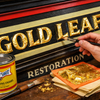Gold Leaf Across the World - Finland
- by Sam Wozniak
Gold Leaf in Finland: A Timeless Tradition of Gilding and Restoration
In the quiet elegance of Finland’s architecture and art, there’s a shimmering detail that often goes unnoticed by the untrained eye — gold leaf (lehtikulta). Though not as immediately associated with opulence as some southern European countries, Finland has a deep, meaningful tradition of gilding (kultaus) that spans centuries. From religious icons to national monuments and meticulous restoration (restaurointi) efforts, both 24 carat (24 karaatin) and 23.5 carat (23,5 karaatin) goldleaf play a vital role in preserving Finnish cultural heritage.
A Nordic History of Gilding
Gold leaf made its way to Finland via ecclesiastical art during the medieval period. As Christianity spread across the Nordic region, Finnish churches began to adopt many European styles, including the use of gilding for decoration and symbolism. Gold was seen as the colour of the divine — radiant and incorruptible — making it perfect for sacred art.
The earliest examples of goldleaf in Finland can be found in religious wooden sculptures, altar pieces, and painted icons. These works, often commissioned by churches between the 13th and 17th centuries, used 23.5 carat gold leaf (23,5 karaatin lehtikulta) to achieve a balance between beauty and durability in the cold, dry climate.
Monumental Gilding in Finnish Churches and Public Spaces
While Finland's gilded architecture is often more modest than that of countries like Italy or Spain, it is no less monumental (monumentaalinen) in cultural and historical significance. The Uspenski Cathedral in Helsinki, for instance, features golden onion domes — each one covered in 24 carat gold leaf (24 karaatin lehtikulta), which gleams under the Nordic sun and symbolizes spiritual enlightenment.
Other examples include the Helsinki Cathedral, whose interiors boast neoclassical elegance accented with gilded columns and fixtures. These uses of gold leaf are more restrained but deeply symbolic, reflecting Finnish values of purity, clarity, and understated beauty.
The Art and Craft of Gilding in Finland Today
Modern-day gilders in Finland continue to use both 23.5 carat and 24 carat gold leaf, depending on the project’s requirements. 23.5 carat goldleaf (23,5 karaatin lehtikulta) is commonly used in projects that require slightly more resistance to wear, such as furniture, frames, or outdoor architectural elements. Meanwhile, 24 carat gold leaf (24 karaatin lehtikulta) is preferred for religious or artistic purposes where purity and brilliance are paramount.
Institutions like the Finnish National Museum and various regional art conservatories offer courses and workshops on traditional gilding techniques, ensuring the craft is passed down to new generations of artisans.
Restoration and Preservation: Keeping Finland’s Gold Shining
One of the most critical modern uses of gold leaf in Finland is restoration (restaurointi). Whether reviving a centuries-old icon in a countryside church or restoring gilded details in a historical government building, gold leaf is essential for authentic preservation. Restoration experts use techniques that respect the original methods — applying thin layers of goldleaf with water or oil-based adhesives, and often burnishing the final layer to a radiant finish.
These restoration projects are not just about visual appeal; they are acts of cultural stewardship. They ensure that the artistry and symbolism of gold leaf continue to enrich Finnish heritage sites and institutions.
Contemporary Gold Leaf in Finnish Art and Design
Gold leaf has also found a place in contemporary Finnish design and fine art. Modern artists are integrating lehtikulta into paintings, sculptures, and even product packaging to create a dialogue between tradition and innovation. From minimalistic canvas works to ornate public installations, goldleaf in Finland remains a living, evolving medium.
This blend of old and new shows that gilding is not merely a relic of the past — it is an adaptable art form that continues to resonate with Finnish values of craftsmanship, sustainability, and aesthetic clarity.
Conclusion: A Quiet Radiance That Endures
Finland’s relationship with gold leaf is both subtle and profound. Whether in monumental churches, intimate icons, or meticulous restoration efforts, the use of 23.5 carat and 24 carat goldleaf continues to reflect the country's dedication to beauty, meaning, and heritage. As techniques evolve and interest in traditional craftsmanship grows, Finland’s gilded legacy will continue to shine — quietly, but unmistakably.






